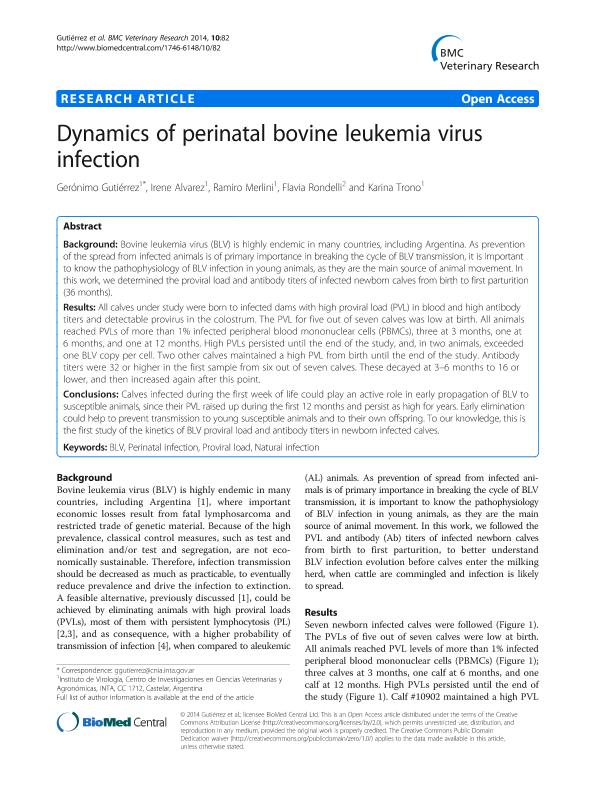Artículo
Dynamics of perinatal bovine leukemia virus infection
Fecha de publicación:
04/2014
Editorial:
BioMed Central
Revista:
BMC Veterinary Research
ISSN:
1746-6148
Idioma:
Inglés
Tipo de recurso:
Artículo publicado
Clasificación temática:
Resumen
BACKGROUND: Bovine leukemia virus (BLV) is highly endemic in many countries, including Argentina. As prevention of the spread from infected animals is of primary importance in breaking the cycle of BLV transmission, it is important to know the pathophysiology of BLV infection in young animals, as they are the main source of animal movement. In this work, we determined the proviral load and antibody titers of infected newborn calves from birth to first parturition (36 months).
RESULTS: All calves under study were born to infected dams with high proviral load (PVL) in blood and high antibody titers and detectable provirus in the colostrum. The PVL for five out of seven calves was low at birth. All animals reached PVLs of more than 1% infected peripheral blood mononuclear cells (PBMCs), three at 3 months, one at 6 months, and one at 12 months. High PVLs persisted until the end of the study, and, in two animals, exceeded one BLV copy per cell. Two other calves maintained a high PVL from birth until the end of the study. Antibody titers were 32 or higher in the first sample from six out of seven calves. These decayed at 3–6 months to 16 or lower, and then increased again after this point.
CONCLUSIONS: Calves infected during the first week of life could play an active role in early propagation of BLV to susceptible animals, since their PVL raised up during the first 12 months and persist as high for years. Early elimination could help to prevent transmission to young susceptible animals and to their own offspring. To our knowledge, this is the first study of the kinetics of BLV proviral load and antibody titers in newborn infected calves.
Palabras clave:
Blv
,
Perinatal Infection
,
Proviral Load
,
Natural Infection
Archivos asociados
Licencia
Identificadores
Colecciones
Articulos(SEDE CENTRAL)
Articulos de SEDE CENTRAL
Articulos de SEDE CENTRAL
Citación
Gutiérrez, Gerónimo; Alvarez, Irene; Merlini, Ramiro; Rondelli, Flavia; Trono, Karina Gabriela; Dynamics of perinatal bovine leukemia virus infection; BioMed Central; BMC Veterinary Research; 10; 82; 4-2014; 82-87
Compartir
Altmétricas




